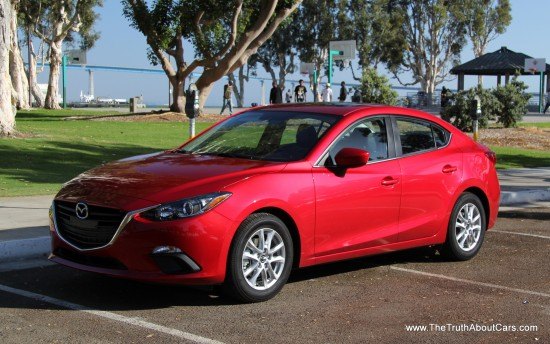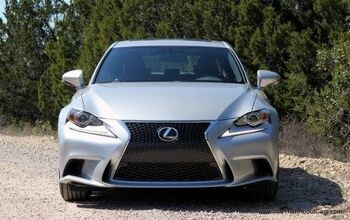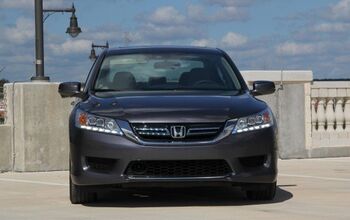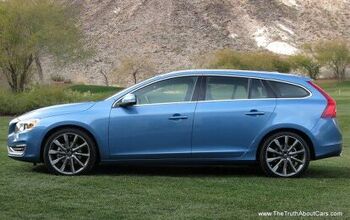First Drive Review: 2014 Mazda3 (With Video)

The mainstream compact car segment is the perfect example of the infamous “driving appliance.” The Corolla and Civic sell in enormous volume because they are the middle-of-the-road “white bread” option, not in-spite of the vanilla. Unlike many in the automotive press, I don’t find anything wrong with that. In fact, I love me some Wonder Bread. But sometimes you feel like a pumpernickel, and that’s where the 2014 Mazda3 comes in. Mazda was so excited about their new loaf that they invited me to spend the day with them in San Diego. Want to know if you should spend 5+ years with one? Click through the jump.
Exterior
The 2014 dimensions play a huge role in the way the 3 looks on the road. Mazda moved the A-pillar 3.5 inches to the rear making the hood longer, lengthened the wheelbase by 2.5 inches, dropped the height by 6/10ths and made the whole car 1.6 inches wider. So far so good, but somehow Mazda managed to slash the front overhang and increase the wheel-to-front-door distance to an almost RWD like proportion. That would probably have been enough in a segment dominated by slab sides, but Mazda puts two distinctive character lines to separate the 3 from the pack. Out back we have tail lamps that mimic the front styling and your choice of a hatch or a trunk. Opting for the hatch gives the Mazda3 a side profile reminiscent of BMW’s X1, not a bad thing to be reminded of.
Interior
Mazda says they benchmarked the BMW 3-Series interior which, given that BMW’s 3 went downmarket in some ways makes the comparison valid in a way that it would have been laughable in 2006. Except for a segment average headliner, the plastics and materials choices in the cabin are all top of the class. (A logical finding since it is the newest as well.) Seat comfort proved excellent with well positioned controls and more side bolstering than you would find in the competition’s non-performance models. Rear seat room was a problem for the last generation Mazda3 and, despite the stretch, this continues to be an area where it lags the competition. For the biggest back seats and the largest trunk, look to the Corolla. Toyota’s 2014 offering has more leg room than the mid-sized Mazda6.
Despite a long list of optional features and gadgets, real leather seating surfaces happen only in the sGrand Touring model with mid-range models sporting faux-cow and lower end 3s wearing fabric. Some comment has been made in the press about the 3’s 1990s era headliner, but it failed to offend me and here’s why: This segment is all about value and value is about cutting corners. Want snazzy dash plastics and metal trim bits-and-bobs? That headliner is the toll you have to pay and it’s one I’m OK with.
The system is as intuitive and snappy as the Mazda6’s is slow and painful. High resolution graphics, a completely redesigned interface and vastly improved voice commands join to create a system that rivals uConnect, iDrive and MyFord Touch for best in the industry. In that comparison the only things MazdaConnect lacks is smartphone app integration and some form of crash-notifying telematics system. If you want to dive into the details, check out the video.
The minimum point of entry for Mazda Connect is $23,340 because you cab only get it in the iTouring model with a $1,600 option package. Ouch. All models that directly compete with the white-loaf get something that looks like a clock radio molded into the dashboard (see the picture above). The logic was to keep the controls high and in the line of sight for the driver to reduce distraction and it does work as intended even though it looks a little odd. If you’re a high roller Mazda offers a high level of tech for this segment with everything from blind spot monitoring and backup cams available to surround sound, radar cruise control, collision prevention systems that will stop the car below 19 MPH (just like Volvo’s City Safety system), parking sensors and automatic high beams.
2014 also brings Mazda’s new “it’s-so-mild-that’s-not-called-a-mild-hybrid” system to the 3. i-Eloop’s is a mild energy recovery system that uses a large capacitor, variable voltage alternator and a DC-DC converter to recover energy when decelerating. The goal of the system is to limit the parasitic loss of the alternator by charging the capacity when you’re braking so that the car can disengage the alternator and use that power while accelerating or cruising. The system can’t help drive the car, which is why Mazda doesn’t call it a hybrid system, but the claim is that it can give you around one extra MPG in certain city driving cycles. Why so little? Because the alternator consumes less engine power than your air conditioning. The system is only available as part of a technology package and only on the top-end sGrand Touring model.
Drivetrain
With the final piece of the SkyActiv puzzle in place, Mazda cranked up the compression ratio on their new 2.0 and 2.5L engines to 13:1. Why not the 14:1 that Mazda advertises in Europe? Because in the USA all engines must operate “safely” on regular 87 octane gasoline by law. The boffins tell us that this results in a 5% loss of efficiency vs the higher compression EU engines that will grenade themselves on lower octane fuel.
The base engine for 2014 is a 2.0L 155 horse four-cylinder that’s good for 150 lb-ft of twist and 30/41/34 MPG (City/Highway/Combined) with the 6-speed automatic. If you have the cash you can upgrade to the 2.5L engine (shared with the CX-5 and Mazda6) which bumps these numbers up to 184 horses and 185 lb-ft while dropping fuel economy to 28/39/32.
The 2.0L engine comes standard with a slick shifting 6-speed transmission that is one of the best manuals in the ever shrinking compact segment. Engagement is precise, throws are moderate and the clutch engagement is linear and well-balanced in relation to the motion of the other two pedals. Sadly this transmission can’t be had with the more powerful 2.5L engine. Don’t shoot the messenger. Most Mazda3s rolling off the lot will use Mazda’s 6-speed automatic transaxle which chases efficiency and a direct feel by engaging the torque converter lockup clutch in every gear, as soon as possible, and as long as possible. While Mazda tells us this is unique to the compact segment, ZF’s 8-speed RWD transmission plays the same trick in the name of efficiency. Manual lovers and speed freaks should know that Mazda is cagey about a MazdaSpeed3 only saying that there would not be one “at launch.” Read between the lines if you like.
Drive
Being the mechanical geek that I am, one more thing caught my interest: the caster angle. That’s the angle that the steering mechanism acts upon the front wheel. Think of this like a clock with vertical being right at 12:00. Most cars out there have a slight caster angle of maybe 12:03 while the 2014 Mazda3 winds it up to 12:06. Why does it matter? Because we have electric power steering (EPAS). EPAS is the modern equalizer and has made all steering dull and lifeless. By dialing up the caster, you dial up the forces that come back up the steering column from the tires. This means that by the time EPAS dulls everything down there’s the hint of something left. I’d like to say it turns the Mazda3 into a Mazda Miata but I’d be lying. Instead what you get is a hint of feedback in corners and a tiny touch of road feel at other times. Because we’ve been living in a feedback-desert, the taste has overly excited some. No it isn’t your 2007 Mazdaspeed3, but it is livelier than the Focus or Civic.
Zoom-Zoom is more about handling than 0-60 times, made obvious by our 7.6 second run to 60 in a hatchback with the 2.5L engine. If you want more speed in the “non-hot hatch segment”, wait for Kia’s turbo Forte I didn’t get a chance to test the 2.0L model during the event but my “butt-dyno” tells me it should be about 2 seconds slower and right in line with the competition. It’s when the road starts to curve that the difference is obvious. This 3 can dance. The Mazda is quite simply the best handling and best feeling compact car in stock form. Yes, the Civic Si is a hair more fun but it’s not a main stream car, doesn’t have an automatic and still doesn’t feel as connected as the Mazda. With road manners like these, I’m looking forward to a Mazdaspeed3 vs Focus ST shootout, I suspect the 3 might dethrone Ford’s hot hatch.
What about daily driving? It’s all well and good to be the best handling compact, but in order to be a sales success you have to be able to sway some white bread buyers. Sound levels at 50MPH rang in a 73db, below the Corolla but above the Civic. No worries there. The sedan’s ride is on the stiffer side of the segment but quite similar to the Focus, that might be a problem for the average Corolla shopper. The big selling point for most cross-shoppers will be the fuel economy. The sedan with the 2.0L engine and automatic is the volume model and snags 30/41/34 MPG (City/Highway/Combined). That’s one MPG better than Sentra, two better than Civic or Corolla and three better than Focus. While that doesn’t translate into much cash saved on an annual basis, it is one of the largest purchase factors shoppers site in this segment. I should mention however that the last time we had the Sentra it scored better than it’s EPA rating while the Mazda3 was fairly close to the EPA score. My big take away from this is that Mazda managed to beat the CVT equipped competition’s fuel economy with a more traditional feeling automatic. White bread buyers won’t care about the feel, but the numbers might cause them to take a second look.
With pricing that ranges from $16,945 (sedan) to a hair under $30,000 (loaded hatch) if you check all the option boxes on a Mazda3 hatch, it’s obvious the Mazda spans the price spectrum from white bread in a bag to a paper-wrapped organic artisan cheesy sourdough. Like the Ford Focus, this large price span means the $19,495 iSport and $20,645 iTouring compete with the bulk of Corolla/Civic shoppers while the upper level trims compete with the Ford Focus, Acura ILX, Lexus CT200h, Buick Verano, and the few that shopped Volvo’s defunct C30.
Compared to the Civic and Corolla, the Mazda3 delivers superior dynamics and more premium dash materials in exchange for less tech and no touchscreen infotainment. This is a dangerous trade in a segment known for placing features before fun. On the flip side, the Mazda3 has everything it needs to compete with the Focus, ILX, Verano and CT200h. Mazda’s chassis tuning makes the Mazda the most fun to drive (even considering the ILX 2.4’s Civic Si roots), the infotainment system is entry-level luxury worthy and 2014 brings all full-speed range radar cruise control and ever gadget the Buick and Lexus shopper could want. So is the Mazda3 the perfect pumpernickel for Wonder Bread prices? As good as. Civirolla shoppers who can be convinced to cross-shop will be pleased with Mazda’s sexy exterior, comfortable seats and road manners, but those after large seats and large trunks will return to the white bread alternative. I suspect the near luxury shoppers are the ones that will miss out the most however thinking that nothing this tasty could come in a package with a Mazda logo on it. Their loss.
Mazda flew me to San Diego, put me up in a hotel and fed me stuffed mushrooms.
Specifications as tested
0-30: 4 Seconds
0-60: 7.6 Seconds
Interior sound level at 50 MPH: 73 db

More by Alex L. Dykes
Latest Car Reviews
Read moreLatest Product Reviews
Read moreRecent Comments
- ToolGuy This thing here is interesting.For example, I can select "Historical" and "EV stock" and "Cars" and "USA" and see how many BEVs and PHEVs were on U.S. roads from 2010 to 2023."EV stock share" is also interesting. Or perhaps you prefer "EV sales share".If you are in the U.S., whatever you do, do not select "World" in the 'Region' dropdown. It might blow your small insular mind. 😉
- ToolGuy This podcast was pretty interesting. I listened to it this morning, and now I am commenting. Listened to the podcast, now commenting on the podcast. See how this works? LOL.
- VoGhost If you want this to succeed, enlarge the battery and make the vehicle in Spartanburg so you buyers get the $7,500 discount.
- Jeff Look at the the 65 and 66 Pontiacs some of the most beautiful and well made Pontiacs. 66 Olds Toronado and 67 Cadillac Eldorado were beautiful as well. Mercury had some really nice looking cars during the 60s as well. The 69 thru 72 Grand Prix were nice along with the first generation of Monte Carlo 70 thru 72. Midsize GM cars were nice as well.The 69s were still good but the cheapening started in 68. Even the 70s GMs were good but fit and finish took a dive especially the interiors with more plastics and more shared interiors.
- Proud2BUnion I typically recommend that no matter what make or model you purchase used, just assure that is HAS a prior salvage/rebuilt title. Best "Bang for your buck"!


















































Comments
Join the conversation
The Mazda3 sGT we drove - a sedan vs. the hatch - was very much the car Alex described. Brand stereotypes, aesthetic opinions and views on Mazda Inc. aside, this specific car at the sGT level is very impressive in finish & features, nimble on city streets and has a lot of scoot, especially using the paddles. Alex, keep using the decibel readings but recalibrate your understanding of what they mean. It's a logarithmic scale and e.g 3db is a *very* meaningful difference. Just to give you a sense for how much, you measured this car at 73db and 85db of sustained sound can cause hearing loss. The only big miss in this review: Noting the consequences of buying from very small Mazda. Mazda lacks depth and breadth in its platforms, engines, warranty coverage and much else. The dealers are typically of relatively small size and so with less ability to pamper, fewer broadly trained mechanics, and U.S. dealers are soon to be further weeded out if you listen to Mazda's Chairman. Given Mazda's limited economy of scale, it's quite remarkable Mazda has produced a compact car of this caliber. We'll buy soon and this is currently at the top of our list.
Just test drove a touring level 3 yesterday. I really liked it. Small cars have come a long ways.